SOWING THE PEAS.
A mellor época de botar os chícharos, é durante os meses de xaneiro e fevreiro, anque pode ser tamén no março. Todo isto, depende de como veña o tempo.
The best time to plant the peas is during the months of January and February, although it can also be in March. All this depends on how the weather comes.
Na nosa casa, a cras da pranta dos chícharos, sempre
é de medio enrame. Isto débese a que as de pequeno enrame, son moi pequenas.
E as ghrandes, soborpasan a altura do invernadeiro.
In our house, the kind of plant of the peas, is always of half height. This is because the plants of small height, are very small. And the large, exceed the height of the structure of the greenhouse.
In our house, the kind of plant of the peas, is always of half height. This is because the plants of small height, are very small. And the large, exceed the height of the structure of the greenhouse.
En resume, o labor de botar os chícharos, consta das seghuintes acçións cíclicas, rotativas ou bucles:
In short, the work of planting the peas, consists of the following cyclic, rotating or looping actions:
Estercar
Fertilise
Abrir ou levantar o primeiro regho.
Open or to "lift" the first furrow.
Ripar.
Cut or peel with the hoe, below the roots of the herbs and other ("ripar").
Sementar ou botar os chícharos.
Sow the peas.
Façer ou levantar a mesada.
Fertilise
Fotos de cavado, sábado 24.02.2018
Pictures of dug, 24.02.2018
Caghallas de coello (comprados por saco)
Rabbit "manure" (bought by sacks)
Abrir ou levantar o primeiro regho.
Open or to "lift" the first furrow.
Ripar.
Cut or peel with the hoe, below the roots of the herbs and other ("ripar").
Fotos de cavado, sábado 24.02.2018
Pictures of dug, 24.02.2018
Sementar ou botar os chícharos.
Sow the peas.
Do or to lift the "mesada". (Line of earth dug and accumulated in the form of "soil ridge, wave or mountain range").
Cotear.
"Cotear" (Level the ground with the opposite part of the hoe).
Leira: terreo de labrança. Ex.: Unha leira de patacas.
Field: tillage field. Example: potatoes field.
Tallo: cada unha das partes en que se redistribúe unha
horta para botar unha crase de hortaliças e leghumes. Ex.: Botou un tallo de tomates. Un
tallo de çebolo.
"Tallo": each of the parts in which vegetable garden is redistributed to plant a class of vegetables and legumes. Example: You planted tomatoes in that plot in the vegetable garden. A plot in the vegetable garden, with onions.
NOTA: Este tallo xa estaba cavado, porque se plantaran outros froitos antes. Non tiña prácticamente, malas herbas. Polo tanto, a fase de "ripar" ou "ripado" non pode mostrarse dun xeito claro, xa que non hai terróns (herbas e demáis).
Fotos de cavado, sábado 24.02.2018
Pictures of dug, 24.02.2018
Cotear.
"Cotear" (Level the ground with the opposite part of the hoe).
Acheghar a leira, ou acheghar o tallo.
Approximately: "Bring the crop field or tillage field closer", or "to bring a plot of the vegetable garden closer" (Drag some soil from the "mesada" to cover the last open furrow).
Fotos de cavado, sábado 24.02.2018
Pictures of dug, 24.02.2018
Leira: terreo de labrança. Ex.: Unha leira de patacas.
Field: tillage field. Example: potatoes field.
"Tallo": each of the parts in which vegetable garden is redistributed to plant a class of vegetables and legumes. Example: You planted tomatoes in that plot in the vegetable garden. A plot in the vegetable garden, with onions.
Fotos de cavado, sábado 24.02.2018
Pictures of dug, 24.02.2018
NOTA: Este tallo xa estaba cavado, porque se plantaran outros froitos antes. Non tiña prácticamente, malas herbas. Polo tanto, a fase de "ripar" ou "ripado" non pode mostrarse dun xeito claro, xa que non hai terróns (herbas e demáis).
NOTE: This portion of the vegetable garden was already dug, because other fruits had been planted before. It had practically no weeds. Therefore, the phase of "ripar" or "ripado" (cutting with the hoe below the roots, weeds and others), can not be shown clearly, since there are no clods (herbs and others).
Caghallas de coello (comprados por saco)
Rabbit "manure" (bought by sacks)
En primeiro lughar, estercar (esparexer o "esterco" por riba da terra ou, botalo adentro do regho cando se abre). Pode ser esterco de vaca, de porco, caghallas ou esterco de ghaliñas, ghalos, caghallas de coello, ..., tonas de froita, restos de comida, borralla etç.
In the first place, fertilise with manure (spread the "manure" above the ground or, throw it into the furrow when it is opened by the hoe or, the plough). It can be manure of cow, pig, hens, roosters, rabbits, ..., fruit peels, leftovers of food, wood ash ... etc.
En seghundo lughar, “ábrese ou levántase o regho” do tallo ou, se cadra, dunha leira.
Secondly, the "furrow" of the portion of the vegetable garden or, if appropriate, of a cultivation field, is "opened or lifted".
Para abrir ese primeiro regho no “tallo”, cávase cunha
leghoña / lighoña, sacha, sacho. Sácanse os terróns, çiscándoos polo chan e
lonxe do regho.
To open that first furrow in the vegetable garden portion, we dig with a hoe ... The clods are removed, spreading them down the ground and away from the furrow.
To open that first furrow in the vegetable garden portion, we dig with a hoe ... The clods are removed, spreading them down the ground and away from the furrow.
Cando a extensión é ghrande, poñamos por caso unha leira, ábrense os reghos cun arado.
When the extension is large, for example a tillage field, the furrows are opened with a plow.
En terçeiro lughar, “rípase”. Esta acçión denominada,
como verbo infinitivo: “ripar”, fai que consighamos a “ripada” ou o “ripado”. Consiste
en:
Cortar ou pelar coa leghoña, ... por debaixo das raíçes da herba e demáis vexetaçión que haba, chamada: “terrón”-“terróns”. O terrón que vai na leghoña ..., envorcámolo ao regho aberto antes, pero volteando a ferramenta para que quede coa herba para baixo e a terra coas raíçes para riba. Se fixera falta tapar os ocos entre os terróns envorcados no regho, ou achandalo mellor, entón collemos coa lighoña, terra do sitio que limpamos antes e, botámoslla.
In third place, it is necessary to "ripar". With this action called in infinitive verb: "ripar", we get the "ripada" or the "ripado". It consists in:
Cortar ou pelar coa leghoña, ... por debaixo das raíçes da herba e demáis vexetaçión que haba, chamada: “terrón”-“terróns”. O terrón que vai na leghoña ..., envorcámolo ao regho aberto antes, pero volteando a ferramenta para que quede coa herba para baixo e a terra coas raíçes para riba. Se fixera falta tapar os ocos entre os terróns envorcados no regho, ou achandalo mellor, entón collemos coa lighoña, terra do sitio que limpamos antes e, botámoslla.
In third place, it is necessary to "ripar". With this action called in infinitive verb: "ripar", we get the "ripada" or the "ripado". It consists in:
Cut or peel with the hoe, below the roots of the herbs and other ("ripar"), called clod or clods of soil. The clod that is in the hoe ..., we are going to throw it into the open furrow before. But, at that moment, we turn the tool so that the clod remains in the furrow with the grass upside down and the earth plus its roots up. If it is necessary to cover the gaps between the clods thrown into the furrow, or level better, then with the hoe, we take soil from the place that we cleaned before and, we throw it into the furrow.
En cuarto lughar, coa mesma man bótanse os chícharos por riba da "ripada" ou "ripado", do regho tapado. (Ao final, queda outra marxa do ripado sen sementar, situada a carón do regho tapado e sementado).
In fourth place, we deposit with the same hand, the "seed of the peas" over the "ripada" or "ripado" of the covered and leveled furrow. (In the end, there is another strip of the "ripado" without sowing, located next to the covered furrow and sown on the surface).
En quinto lughar, abrir ou levantar o seghundo regho na marxa ripada sen semente. Para isto, cavamos coa leghoña ... (Esto explica a seghuinte fase).
Fifth, we must open a second furrow in that margin of the "ripada" that is not sown. For this, we dig with the hoe ... (This explains the next phase).
Sexto lughar. “Façer a mesada” ou “levantar a mesada”. A terra que sacamos na cavada ou cavadura da fase anterior, vaise botando enriba da marxa ripada que ten os chícharos, para tapalos. A onda ou cordilleira, formada pola terra enriba dos chícharos, chámase “mesada”.
Sixth place. "Make the mesada" or "Lift the mesada". The soil that we extract in the digging of the previous phase, is thrown on top of the "ripada" strip that has the seed of the peas, to cover them. The "soil ridge", "wave" or "mountain range", formed by the soil above the peas, is called "mesada".
En sétimo lughar. “Cotear a mesada”. Significa baixar ou achandar coa cota da leghoña ..., a mesada (onda ou cordilleira de terra) para nivelala.
In seventh place. "Cotear the mesada". It means lowering or leveling with the back of the hoe ..., the "mesada" (soil ridge) to level it.
Repetimos proghresivamente todas estas distintas fases, ata acabar os chícharos que queiramos sementar.
We gradually repeat all these different phases until we finish the peas we want to sow.
Oitavo lughar, “acheghar a leira”, neste caso, “acheghar o tallo”. A causa desta acçión é que no momento final, queda un regho aberto. Esta denominaçión, consiste en tapar o regho. Para loghralo, pódese coller terra coa leghoña, da parte alta da última mesada, arrastrándoa adentro do regho, e achandando a superfiçie. Debe terse coidado de non arrastrar os chícharos sementados, que están debaixo da mesada.
Eighth place. Approximately: "Bring the crop field or tillage field closer". In this case "to bring a plot of the vegetable garden closer". The cause of this action is that, in the final moment, there is an open furrow. This denomination consists of covering the furrow. To achieve this, you can take soil with the hoe, of the last "soil ridge" ("mesada"), dragging it inside the furrow to cover it and smoothing the surface. Care must be taken not to drag the seeds, which are deposited under the soil ridge.
NOTA: Todas as mesadas, cotéanse para achandar o “tallo”
dos chícharos, ou de ser o caso, a “leira” dos chícharos. É preferible cotear
mesada por mesada, para non pisar os chícharos. Xa que se empeçamos a cotear xa
rematados os chícharos, estarémolos pisando case desde a primeira sementadura, ata a
última.
NOTE: All the soil ridges (mesadas), are reduced to level (cotear) the part of the vegetable garden, where the peas are being planted, or if it is the case, the field of peas. It is preferable to level ridge by ridge, so as not to step on the peas. Because, if we begin to level when we finish sowing the peas, we will be trampling them almost from the first seeding, until the last one.
NOTE: All the soil ridges (mesadas), are reduced to level (cotear) the part of the vegetable garden, where the peas are being planted, or if it is the case, the field of peas. It is preferable to level ridge by ridge, so as not to step on the peas. Because, if we begin to level when we finish sowing the peas, we will be trampling them almost from the first seeding, until the last one.
Pouco a pouco, a semente do chícharo começará a xurdir da
terra e, a inçar no tallo.
Little by little, the seed of the pea will begin to sprout from the earth and to grow in the vegetable garden plot.
Little by little, the seed of the pea will begin to sprout from the earth and to grow in the vegetable garden plot.
Domingo, 8.04.2018
Sunday, 8.04.2018
Mentres a pranta sexa pequeniña, déixase medrar sen
intervençión nincunha. Iso sí, deberemos mondar (arrincar as malas herbas), nas
diferentes etapas do seu creçemento.
Meanwhile the plant is tiny, it will grow without any intervention. Of course, we must remove the weeds, in the different phases of its growth.
Meanwhile the plant is tiny, it will grow without any intervention. Of course, we must remove the weeds, in the different phases of its growth.
Domingo, 8.04.2
Sunday, 8.04.2018
Ao alcançar unha determinada altura, é cando se lle poñen
unhas estacas con ou sen ghallas. Poden ser de pau de carballo, sanquiños, canas etç.
Esto axudaraas a ghabear para aproveitar a lus, evitando que estean arrastro no chan.
When they reach a certain height, it is when you put some stakes with or without ramifications. They can be small rods of oak, dogwood, cane etc. This will help them to ascend to take advantage of the light, preventing them from crawling on the ground.
Mércores, 25.04.2018
When they reach a certain height, it is when you put some stakes with or without ramifications. They can be small rods of oak, dogwood, cane etc. This will help them to ascend to take advantage of the light, preventing them from crawling on the ground.
Mércores, 25.04.2018
Wednesday, 25.04.2018
Anque apareçan as primeiras vaxinas, aínda non se lle pon
a rede ata que se vexan andar aos paxaros (polo reghular, as peghas) arredor delas peteirándoas. A rede non se lle pon antes, para non “afoghar” as plantas
coa presión dela.
Although the first pods appear, the net is still not put on until the birds (to a greater extent, jays) are seen, around them to peck them. The net is not put before, so as not to "drown" the plants with the pressure of it.
Although the first pods appear, the net is still not put on until the birds (to a greater extent, jays) are seen, around them to peck them. The net is not put before, so as not to "drown" the plants with the pressure of it.
Martes, 15.05.2018
Tuesday, 15.05.2018
Dominco 27.05.2018
Sunday 27.05.2018
Mércores, 20.06.2018
Wednesday, 20.06.2018
The pods are checked, to see if they have the grain already achieved. For those who have the peas formed, the net is partially removed and they are caught to make meals. Then, they put the net back again.
Mércores, 20.06.2018
Wednesday, 20.06.2018
Pode ser que unhas vaxinas estean máis cheas e, outras
máis atrasadas. Apáñanse as cheas e, déixanse as outras.
It could be that some pods are fuller and others not fully developed. The full ones are collected and the others are left.
It could be that some pods are fuller and others not fully developed. The full ones are collected and the others are left.
Mércores, 20.06.2018
Wednesday, 20.06.2018
No intre en que todas medren totalmente, retírase
completamente a rede. Entón, sácanse as estacas e, recóllense a eito en baldes,
caldeiros, reçipientes etç. As estacas que valen, ghárdanse para o ano que vén,
se aghuantan. Senón, tíranse á terra para estercar ou, senón como leña para queimar no lume.
When all of them are fully developed, the net is completely taken off. Then, the stakes are removed and the pods are collected in their entirety. We throw them in basins, buckets, containers etc. The stakes that are worth, they are saved for the next year, if they hold. If not, they are thrown to the ground to fertilize it, or to burn like firewood.
When all of them are fully developed, the net is completely taken off. Then, the stakes are removed and the pods are collected in their entirety. We throw them in basins, buckets, containers etc. The stakes that are worth, they are saved for the next year, if they hold. If not, they are thrown to the ground to fertilize it, or to burn like firewood.
Mércores, 20.06.2018
Wednesday, 20.06.2018
Polo que se refire, ás ramas sen os chícharos (sen as
vaxinas), arríncanse e, acarréxanse en mandos a outro sitio, para amorealas
(xuntalas nunha morea), coa fin de que pudran e façer esterco.
As regards, the plants without the peas (without the pods), they uproot them from the ground. Then, they take them in arms to another place, to pile them up (put them together in a heap), in order to rot and make manure.
As regards, the plants without the peas (without the pods), they uproot them from the ground. Then, they take them in arms to another place, to pile them up (put them together in a heap), in order to rot and make manure.
Mércores, 20.06.2018
Wednesday, 20.06.2018
Despois, lévanse os reçipientes con elas para a casa. Desbúllanse (abrir as vaxinas e sacarlle os chícharos). Vanse botando os chícharos en bandexas, fontes, palancanas, coadores etç.
Afterwards, the containers are taken with the pods for home. The peas are shelled and thrown in trays, platters, basins, colanders etc.
Mércores, 20.06.2018
Posteriormente, escóllense, desbotando os inservibles.
Límpanse (quítanselle os lixos). Lávanse e métense en bulsas para logho,
conxelar.
Subsequently, the peas are chosen, discarding the unusable ones. They clean them, removing the impurities. They are washed and put in bags to freeze.
Subsequently, the peas are chosen, discarding the unusable ones. They clean them, removing the impurities. They are washed and put in bags to freeze.
Mércores, 20.06.2018
Wednesday, 20.06.2018
EXPRESIÓNS DUNHA CONVERSA:
¿Elogho, cavastes moito?
¡Ai! Aínda fixemos tres ou catro mesadas. = ¡Ai! Aínda levantamos tres ou catro mesadas.
¡Ai! Inda fixemos tres ou catros mesadas = ¡Ai! Inda levantamos tres ou catro mesadas.
EXPRESSIONS OF A CONVERSATION:
And then, did you dig a lot?
Ai! We still made three or four "mesadas" (soil ridges).
= Ai! We still lifted three or four "mesadas" (soil ridges).
EXPRESSIONS OF A CONVERSATION:
And then, did you dig a lot?
Ai! We still made three or four "mesadas" (soil ridges).
= Ai! We still lifted three or four "mesadas" (soil ridges).
Fotos da horta, tomadas o dominco 28 de outubro de 2018, pola tarde.
Photos of the vegetable garden, taken on Sunday, October 28, 2018, in the afternoon.
Tallo de pementos morróns
Portion or plot of the garden, with sweet peppers

Detrás dos pementos morróns, pódese ver un tallo de coles. En deçembro, xaneiro ou fevreiro, arrincaránse
para plantar nunha leira. Despois da fase anterior, cando estean ghrandes vanse apañando as follas, para
acomerar ghaliñas, ghalos, coellos, porco etç.
Behind the sweet peppers, we can see a parcel of the vegetable garden with collard greens. In December, January or February, they are uprooted to plant in a farmland. After the previous phase, when they are large, leaves are taken to feed the hens, roosters, rabbits, pig etc.
Behind the sweet peppers, we can see a parcel of the vegetable garden with collard greens. In December, January or February, they are uprooted to plant in a farmland. After the previous phase, when they are large, leaves are taken to feed the hens, roosters, rabbits, pig etc.
Tallo de tomates
Parcel of the vegetable garden, with tomatoes
Parte de arriba da horta, con vimbieiros e diversos frutais
Upper part of the vegetable garden, with wickers and small fruit trees

Outro pequeniño tallo de pementos morróns
Another small plot of the vegetable garden, with sweet peppers
Un tallo de rabiças. Foi botado en xullo ou aghosto. Déixanse medrar aquí mesmo. Non se transplantan a nincunha leira. Se están moi mestos, poden ser rareados. Eses posibles pés que se rarean, poden botarse ao caldo, con outras crases de verdura, coma repolo, etç.
A parcel of the vegetable garden, with rabiças. It was planted in July or August. They let themselves grow right here. They do not transplant to another farmland. If they are very dense, they can be spaced, uprooting some. Those possible plants of rabizas that we uprooted, can be thrown into Galician soup, with other kinds of vegetables, like cabbage etc.
Tamén poden ser coçidas con bacallau, touçiño da barrigha (pançeta) ou, simplemente con cachos de ovos coçidos. Tanto co bacallau, co touçiño da barrigha ou cos ovos coçidos, réghaselle açeite de oliva.
They can also be cooked with cod, bacon from the belly of the pork or, simply with boiled eggs, which are cut into small pieces, watering this dish with olive oil.
Co paso dos meses, a finais de xaneiro ou, en fevreiro, poden saírlle xa o ghrelo (brotes de talo recto para riba, con flores amarelas e, follas tenras). Son chamados os "ghrelos de rabiça", moi usados nos pratos que acabamos de expricar.
Over the months, at the end of January or, in February, you can sprout the "ghrelo" (stem shoots straight up, with yellow flowers and tender leaves). They are called "ghrelos de rabiça", widely used in the meals that we have just explained.
NOTA: As rabiças son moi aghres. Por eso, antes de botalas ao caldo, ou cos outros pratos comentados aquí, dáselles unha fervura ou escaldadura e tíraselles esa aghua. Logho, van á ola para acompañar nesas comidas.
NOTE: The rabiças are very sour. For that reason, before throwing them into the pot to make Galician soup, or other meals explained here, we give them a boil and, throw this water out. Then, the rabiças go inside the pot.
Tamén poden ser coçidas con bacallau, touçiño da barrigha (pançeta) ou, simplemente con cachos de ovos coçidos. Tanto co bacallau, co touçiño da barrigha ou cos ovos coçidos, réghaselle açeite de oliva.
They can also be cooked with cod, bacon from the belly of the pork or, simply with boiled eggs, which are cut into small pieces, watering this dish with olive oil.
Co paso dos meses, a finais de xaneiro ou, en fevreiro, poden saírlle xa o ghrelo (brotes de talo recto para riba, con flores amarelas e, follas tenras). Son chamados os "ghrelos de rabiça", moi usados nos pratos que acabamos de expricar.
Over the months, at the end of January or, in February, you can sprout the "ghrelo" (stem shoots straight up, with yellow flowers and tender leaves). They are called "ghrelos de rabiça", widely used in the meals that we have just explained.
NOTA: As rabiças son moi aghres. Por eso, antes de botalas ao caldo, ou cos outros pratos comentados aquí, dáselles unha fervura ou escaldadura e tíraselles esa aghua. Logho, van á ola para acompañar nesas comidas.
NOTE: The rabiças are very sour. For that reason, before throwing them into the pot to make Galician soup, or other meals explained here, we give them a boil and, throw this water out. Then, the rabiças go inside the pot.
Tallo de repolos, xa "escapados" (pasados de tempo) e algho secos. As cabeças de repolo, non fixeron falta. Tampouco, se lle apañaron os xenos (follas tenras que saen rectas para riba) que viñeron máis tarde.
Parcel of the vegetable garden, with cabbages already past of time, and something dry. The heads of cabbage, were not need. Neither, they took the "xenos" (tender leaves that come straight up), which came later.
Morea de ramas dos chícharos, xa podre
Heap of pea plants and their branches, already rotten

Tallo de porros
Parcel of the vegetable garden, with leeks

Peche ou cerrado de canas, con plantas secas. Cando estaban verdes, iban ser transplantadas.
Closure of canes, with already dried plants. When they were green, they were going to be transplanted.
Pexeghueiro
Pêcher
Tallo de melóns
Parcel of the vegetable garden, with melons

Fotos. Dominco 18 de novembro de 2018, pola mañán.
Pementos morróns e detrás, un tallo de coles
Behind the sweet peppers, a parcel of the vegetable garden with collard greens
Tomates coa "ghradisela" de madeira, a medio caer polo vento
Tomatoes, with the wooden structure a little fallen, because of the wind
Pementos morróns
Sweet peppers
Flores e, melons
Flowers and, melons
Un tallo de rabiças.
A parcel of the vegetable garden, with rabiças.
Un melro ou merlo (cor neghra=macho), nas ponlas do pexeghueiro.
A blackbird, on the branches of the peach tree.
Un paparrugho, no pexeghueiro.
A robin or redbreast, on the branches of the peach tree.
Peche ou cerrado de canas, con plantas secas.
Closure of canes, with already dried plants.
Tallo de porros
Parcel of the vegetable garden, with leeks
Tallo reçen cavado e, plantado con nabicoles (pareçidos ás coles, pero máis pequenas). Cando cheghue o momento, arrincaránse
para plantar nunha leira. Despois da fase anterior, cando estean
ghrandes vanse apañando para alimento humano en diferentes comidas.
Parcel of the vegetable garden, freshly dug and planted with nabicolles (similar to the collard greens, but smaller). When the time is right, they are uprooted to plant in a farmland. After the previous phase, when they are large, are collected for human food in different meals.
Tallo de repolos, xa "escapados" (pasados de tempo) e algho secos
Parcel of the vegetable garden, with cabbages already past of time, and something dry
Viña á esquerda (ata os anos oitenta, á dereita tamén había viña).
Vineyard on the left (until the eighties, on the right side there was also a vineyard).
Pexeghueiro
Peach tree
Tomiño (Tomillo), perto do muro de pedra
Thyme near the stone wall
Flores e, melons
Flowers and, melons
A Ría de Arousa, ao fondo, coas bateas de mexillóns. Á esquerda, a Illa da Arousa.
The Arousa estuary, in the background, with its mussel parks. On the left the island of A Arousa.
Outras perspectivas.
Other perspectivas.




































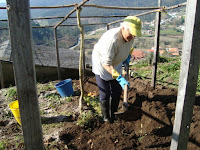













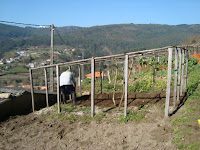












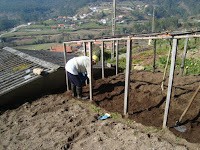























































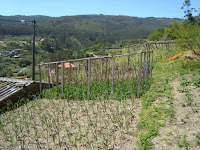






























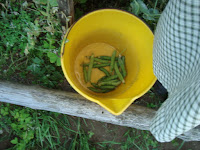

































































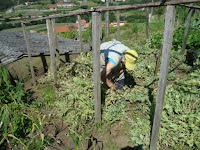













































































































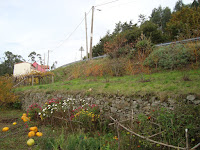



















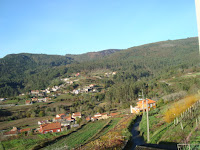












































No hay comentarios:
Publicar un comentario